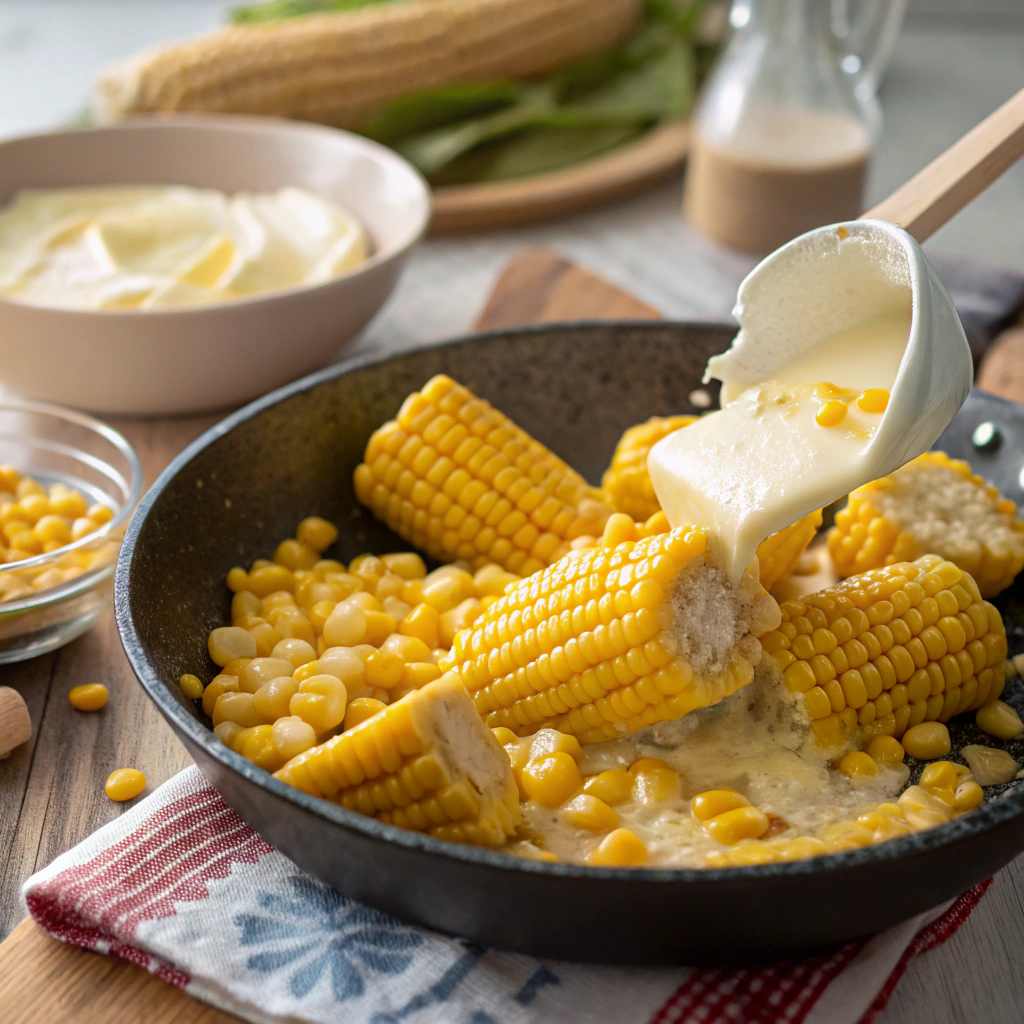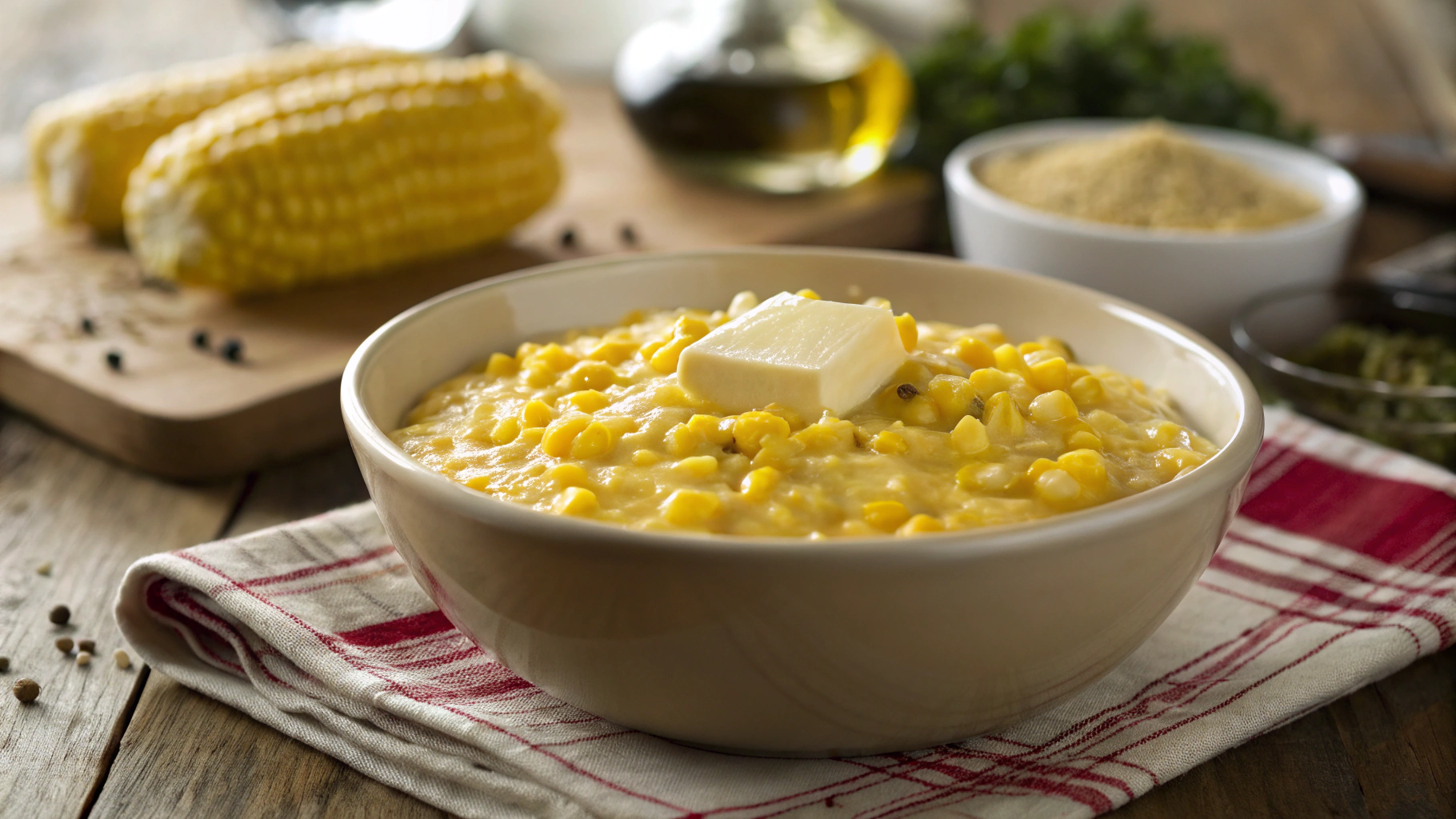Introduction
When it comes to comfort food, few dishes are as beloved as creamed corn. This rich, creamy side dish has become a staple at family gatherings, barbecues, and holiday dinners. However, many people find themselves asking, Is creamed corn the same as canned corn? While the two are related, there are significant differences that make creamed corn stand out. In this article, we’ll explore the nuances between these two types of corn, provide a step-by-step guide to making creamed corn from scratch, and discuss variations, common mistakes, and nutritional benefits. By the end, you’ll know exactly how to create the perfect creamed corn dish that can be enjoyed by everyone.
Ingredients for the Perfect Creamed Corn Recipe
To make a classic creamed corn dish, you need a few key ingredients. These ingredients not only bring out the sweetness of the corn but also help create the creamy, flavorful sauce that makes this dish so irresistible.
For the basic creamed corn recipe, you’ll need:
- Corn kernels (fresh, frozen, or canned): The star of the dish, corn provides both sweetness and texture. Many people wonder, Is creamed corn the same as canned corn? The answer is no, because creamed corn often includes additional ingredients like cream and butter to enhance its flavor.
- Butter: Adds richness and helps to create a smooth, creamy texture.
- Heavy cream: For the creamy base, giving the dish its velvety consistency.
- Milk: Adds a bit of fluidity to the cream and butter mixture, ensuring the dish is neither too thick nor too runny.
- Flour: Used as a thickening agent to give the creamed corn a proper consistency.
- Salt and pepper: Seasoning to taste.
- Sugar: Enhances the natural sweetness of the corn, balancing out the creaminess.
By carefully selecting fresh ingredients or high-quality canned options, you can elevate the taste of your creamed corn and make it the highlight of any meal.
Tools Needed to Prepare Creamed Corn
Having the right tools is crucial to ensure a smooth cooking process. Below are the essential tools for preparing creamed corn:
- Large skillet or sauté pan: To cook the corn and cream mixture evenly.
- Wooden spoon or spatula: For stirring to prevent sticking and to ensure an even distribution of ingredients.
- Measuring spoons and cups: To ensure you use the correct amount of ingredients for the best flavor balance.
- Whisk: Used for incorporating flour into the cream and milk mixture, helping avoid lumps.
- Ladle or serving spoon: For serving the creamed corn once it’s ready.
With these tools on hand, you’ll be able to make the creamed corn recipe with ease and precision.
Step-by-Step Guide to Making Creamed Corn
Making creamed corn from scratch is an easy process that yields delicious results. Here’s a detailed guide to help you prepare this classic dish.
Preparing the Ingredients
- Choose your corn: If you’re using fresh corn, cut the kernels off the cob. Alternatively, frozen or canned corn can be used. If you opt for canned corn, remember that creamed corn is not the same as canned corn—creamed corn typically contains extra ingredients like cream, butter, and seasoning.
- Measure your ingredients: Have all your ingredients ready and measured to streamline the cooking process.
- Melt the butter: In a large skillet, melt the butter over medium heat. This will provide a flavorful base for the dish and prevent the corn from sticking to the pan.

Cooking
- Add the corn: Once the butter is melted, add your prepared corn to the skillet. Stir occasionally to ensure that the corn cooks evenly.
- Season the mixture: Season with salt, pepper, and sugar. The sugar helps to bring out the natural sweetness of the corn, while the salt and pepper balance the flavors.
- Incorporate the flour: Sprinkle flour over the corn mixture. Stir well to combine, as this will thicken the sauce as it cooks. This is one of the key steps in achieving that perfect creamy texture.
Simmering and Adding Flavor
- Add the milk and cream: Gradually pour in the milk and heavy cream. Stir constantly to ensure the mixture remains smooth. Allow the mixture to simmer for about 5–7 minutes, or until the sauce has thickened and the corn is fully cooked.
- Adjust seasoning: Taste the creamed corn and adjust the seasoning as necessary. If you prefer a sweeter flavor, add more sugar. For a more savory taste, increase the salt and pepper.
- Simmer until creamy: Let the creamed corn simmer on low heat for a few more minutes until it reaches a thick, creamy consistency. Stir occasionally to prevent burning and to ensure an even texture.
Variations of the Recipe
While the basic creamed corn recipe is delicious on its own, there are several variations that you can try to personalize it to your tastes. Here are some ideas:
- Spicy creamed corn: Add some chopped jalapeños or a pinch of cayenne pepper to give your creamed corn a spicy kick.
- Cheesy creamed corn: Stir in shredded cheddar cheese for a rich, cheesy version of this dish.
- Bacon creamed corn: Add crispy bacon bits for a smoky, savory twist.
- Herbed creamed corn: Fresh herbs like thyme, rosemary, or parsley can elevate the dish and add an aromatic layer of flavor.
- Vegan creamed corn: Substitute butter and heavy cream with plant-based alternatives like olive oil and coconut cream.
Each variation brings a unique touch to the classic creamed corn, so feel free to experiment and find your favorite version!
Common Mistakes and How to Avoid Them
While making creamed corn is fairly simple, there are a few common mistakes that can affect the final result. Here’s how to avoid them:
- Overcooking the corn: Overcooked corn can become mushy. Be sure to cook the corn just until tender, and avoid simmering for too long.
- Lumpy texture: If the flour isn’t incorporated properly, lumps can form. To prevent this, whisk the flour into the milk before adding it to the pan or ensure it’s well distributed in the butter before adding the liquids.
- Too thick or too runny: If the dish is too thick, add a little more milk or cream. If it’s too runny, allow it to simmer longer to thicken.
- Underseasoning: Don’t forget to taste and adjust the seasoning. The dish can easily become bland without proper seasoning.
By being mindful of these tips, you’ll be able to create perfect creamed corn every time.
Explore the differences between creamed corn and canned corn in our detailed guide on Is Creamed Corn the Same as Canned Corn? and learn how to adjust your recipe for the perfect texture.
Nutritional Benefits
While creamed corn is often considered a comfort food, it also offers some nutritional benefits, making it a satisfying side dish. Here’s a breakdown of what you get from this tasty dish:
- Corn: Packed with fiber, corn is great for digestion and provides a good amount of vitamin C, which supports immune health.
- Butter and cream: These ingredients are rich in fats, which help with the absorption of fat-soluble vitamins like A, D, and E.
- Milk: An excellent source of calcium, milk supports strong bones and teeth.
- Flour: Adds a small amount of carbohydrates and protein to the dish.
While creamed corn can be calorie-dense due to the cream and butter, it provides essential nutrients like fiber, vitamins, and minerals when enjoyed in moderation.
Pairing with Sides and Drinks
Creamed corn is a versatile dish that pairs well with a variety of sides and drinks. Here are some pairing ideas to elevate your meal:
Sides:
- Grilled meats: Pair creamed corn with grilled steak, chicken, or pork for a hearty, satisfying meal.
- Roasted vegetables: Roasted potatoes, carrots, or Brussels sprouts complement the rich creaminess of the corn.
- For a comforting meal, serve this dish alongside mac and cheese.
Drinks:
- Iced tea: A refreshing glass of iced tea balances the rich flavors of creamed corn.
- White wine: A crisp, dry white wine like Sauvignon Blanc pairs wonderfully with the creamy texture of the dish.
- Lemonade: The citrusy zing of lemonade is a perfect match for the sweet and savory flavor of creamed corn.
Experiment with different sides and beverages to find the perfect combination for your next meal.
Can you substitute canned corn for creamed corn?
While you can substitute one for the other in some recipes, they are not identical, and the results will differ in both flavor and texture. One version typically contains whole kernels in a brine, which gives it a firmer texture and more distinct flavor. The other combines kernels with a creamy mixture of butter, cream, and sometimes sugar, creating a smooth and velvety texture. If you decide to use the firmer version, you’ll need to add ingredients like heavy cream, butter, and possibly a thickening agent, such as flour or cornstarch, to replicate the creamy consistency. Although the flavor may be somewhat similar, it won’t match the richness and creaminess of the other option. Therefore, while substituting is possible, adjustments are necessary to achieve the desired texture and flavor in your recipe.
Can you eat creamed corn by itself?
Yes, this dish can definitely be enjoyed by itself. In fact, it’s often served as a standalone side dish at family meals, barbecues, or holiday gatherings. The creamy texture and rich flavor make it a comforting and satisfying choice on its own. While it pairs wonderfully with a variety of main dishes, it can also shine as the star of the meal. For example, it complements meats like fried chicken, roast pork, or grilled steaks, but it can also be enjoyed as a hearty vegetarian option when served with bread or a salad. The indulgent, slightly sweet flavor of butter and cream makes it appealing even without other components. Its smooth, creamy consistency combined with whole kernels gives it a pudding-like texture, making it the perfect comfort food. Whether for a quick snack or a light meal, this dish is a simple and delicious option to enjoy on its own.
What can I substitute for canned corn?
If you’re out of canned corn or prefer not to use it, several substitutes can mimic its flavor and texture. The most common replacement is *frozen corn*, which is often fresher than canned corn and can be used in a 1:1 ratio. Simply thaw or cook it lightly before adding it to your dish. *Fresh corn on the cob* is another option; boil, grill, or roast it, then cut off the kernels to use in place of canned corn. Fresh corn offers a slightly sweeter flavor and firmer texture but works well in most recipes.
For a more unique substitution, *cornmeal* or *corn grits* can be used in dishes like cornbread or casseroles, though the texture will be different. *Hominy*, a processed form of corn, can also serve as a substitute, providing a slightly different texture. For a gluten-free alternative, *quinoa* or *rice* can replace corn in certain recipes, though the flavor will differ somewhat.
Looking for the best clam chowder recipe?
Check out our Best Clam Chowder Recipe and get tips for a creamy and flavorful version. Also, learn how to make it your own with unique variations in our What is a Good Thickener for Clam Chowder? post.
Conclusion: A Simple and Versatile Recipe
In conclusion, this dish is a simple yet versatile option that can be customized to fit your preferences. Whether you’re wondering about the differences between the two types or exploring various ways to make it your own, the key to perfecting it lies in choosing quality ingredients, following the step-by-step process, and avoiding common mistakes. With endless variations and pairing possibilities, it is a dish that can be enjoyed year-round at any meal.


2 thoughts on “Is Creamed Corn the Same as Canned Corn? Recipe and Tips”